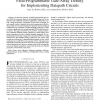FPGA
2005
ACM
15 years 22 days ago
2005
ACM
Floating-point Sparse Matrix-Vector Multiplication (SpMXV) is a key computational kernel in scientific and engineering applications. The poor data locality of sparse matrices sig...
FPGA
2005
ACM
15 years 22 days ago
2005
ACM
Recent works demonstrate several benefits of synthesizing software binaries onto FPGA hardware, including incorporating hardware design into established software tool flows with m...
FPGA
2005
ACM
15 years 22 days ago
2005
ACM
Modern FPGA architectures provide ample routing resources so that designs can be routed successfully. The routing architecture is designed to handle versatile connection configur...
FPGA
2005
ACM
15 years 22 days ago
2005
ACM
We present an automatic logic synthesis method targeted for highperformance asynchronous FPGA (AFPGA) architectures. Our method transforms sequential programs as well as high-leve...
FPGA
2005
ACM
15 years 22 days ago
2005
ACM
Vdd-programmable FPGAs have been proposed recently to reduce FPGA power, where Vdd levels can be customized for different circuit elements and unused circuit elements can be powe...
FPGA
2005
ACM
15 years 22 days ago
2005
ACM
This paper describes the Altera Stratix II™ logic and routing architecture. This architecture features a novel adaptive logic module (ALM) that is based on a 6-LUT, but can be p...
FPGA
2005
ACM
15 years 22 days ago
2005
ACM
Creating a new FPGA is a challenging undertaking because of the significant effort that must be spent on circuit design, layout and verification. It currently takes approximately ...
FPGA
2005
ACM
15 years 22 days ago
2005
ACM
Large, high density FPGAs with high local distributed memory bandwidth surpass the peak floating-point performance of high-end, general-purpose processors. Microprocessors do not...
FPGA
2005
ACM
15 years 22 days ago
2005
ACM
Abstract—As the logic capacity of field-programmable gate arrays (FPGAs) increases, they are increasingly being used to implement large arithmetic-intensive applications, which ...
FPGA
2005
ACM
15 years 22 days ago
2005
ACM
Sublithographic Programmable Logic Arrays can be interconnected and restored using nanoscale wires. Building on a hybrid of bottom-up assembly techniques supported by conventional...



